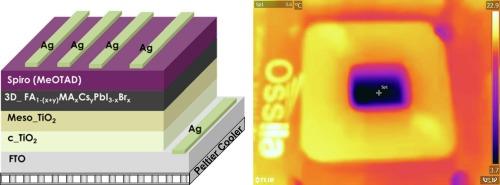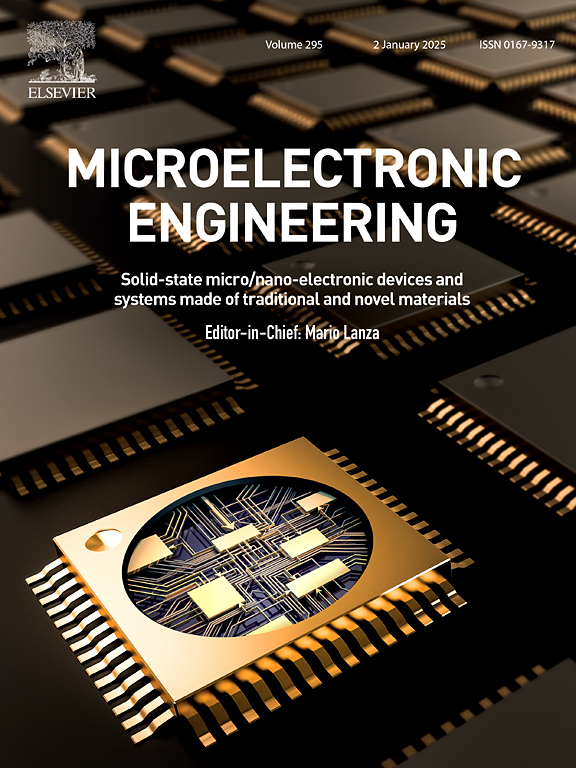Assessing the performance of perovskite solar cells under Peltier cooling
IF 3.1
4区 工程技术
Q2 ENGINEERING, ELECTRICAL & ELECTRONIC
引用次数: 0
Abstract
The commercialization of perovskite solar cells (PSCs) has been restricted so far due to their short life time, which is partly attributed to their instability at high operating temperatures. The current paper studies the performance of the cells under Peltier cooling. The experimental setup includes a perovskite solar cell and a Peltier cooler beneath, where the latter is connected to an external power supply. The temperature on the surface of the solar cell spans over the range ca. 5 °C to 50 °C under 1 sun illumination, depending on the power input of the Peltier cooler. The J-V measurements indicate a non-linear temperature dependence of the power conversion efficiency (PCE), which reaches a maximum of 18.1 % at 27 °C, whereas at temperatures close to 50 °C the PCE drops significantly. The experimental results are combined with more generic theoretical simulations for scaling up the PSC unit, which provides electrical power to the Peltier unit. The simulations examine the ability of different system configurations to maintain the solar cell temperature below 50 °C without significant deterioration of the electrical performance of the hybrid PSC – Peltier device. Overall, the results show that a large-scale PSC – Peltier device is feasible for both roof-integrated and rooftop installation types, in order to protect the solar cell from overheating and degradation.

珀尔帖冷却条件下钙钛矿太阳能电池性能评估
由于钙钛矿太阳能电池(PSCs)的寿命短,其商业化迄今为止一直受到限制,这在一定程度上归因于它们在高温下的不稳定性。本文研究了该电池在珀尔帖冷却条件下的性能。实验装置包括一个钙钛矿太阳能电池和下面的珀尔帖冷却器,后者连接到外部电源。在1个太阳照射下,太阳能电池表面的温度范围约为5°C至50°C,这取决于珀尔捷冷却器的输入功率。J-V测量表明功率转换效率(PCE)与温度呈非线性关系,在27°C时达到最大值18.1%,而在接近50°C时PCE显著下降。实验结果与更通用的理论模拟相结合,用于放大PSC单元,PSC单元为Peltier单元提供电力。模拟测试了不同系统配置的能力,以保持太阳能电池温度低于50°C,而不会显著降低混合PSC - Peltier器件的电气性能。总体而言,结果表明,为了防止太阳能电池过热和退化,大型PSC - Peltier装置对于屋顶集成和屋顶安装类型都是可行的。
本文章由计算机程序翻译,如有差异,请以英文原文为准。
求助全文
约1分钟内获得全文
求助全文
来源期刊

Microelectronic Engineering
工程技术-工程:电子与电气
CiteScore
5.30
自引率
4.30%
发文量
131
审稿时长
29 days
期刊介绍:
Microelectronic Engineering is the premier nanoprocessing, and nanotechnology journal focusing on fabrication of electronic, photonic, bioelectronic, electromechanic and fluidic devices and systems, and their applications in the broad areas of electronics, photonics, energy, life sciences, and environment. It covers also the expanding interdisciplinary field of "more than Moore" and "beyond Moore" integrated nanoelectronics / photonics and micro-/nano-/bio-systems. Through its unique mixture of peer-reviewed articles, reviews, accelerated publications, short and Technical notes, and the latest research news on key developments, Microelectronic Engineering provides comprehensive coverage of this exciting, interdisciplinary and dynamic new field for researchers in academia and professionals in industry.
 求助内容:
求助内容: 应助结果提醒方式:
应助结果提醒方式:


